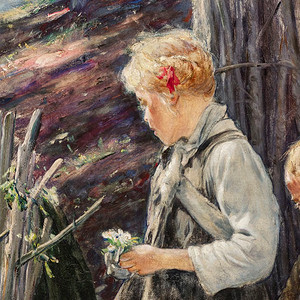True to Life
Belvedere Wien,Prinz Eugen-Straße 27, 1030 Vídeň, Rakousko
March 18, 2022 - October 21, 2022
 Anton Fikuka: Children |
True to LifeBelvedere Wien,Prinz Eugen-Straße 27, 1030 Vídeň, RakouskoMarch 18, 2022 - October 21, 2022
The term "Realism" was introduced by the French painter Gustave Courbet. In 1855, he exhibited his works in a separate building at the World's Fair in Paris and called his presentation Le Réalisme. Courbet chose a completely new, true-to-life, and matter-of-fact manner of representation, emphasizing unconventional motifs that made no concession to the typical embellishing aesthetics prevalent at the time. In the years that followed, Realism gained popularity as an independent style that influenced both European and American painting. Photography, still in its infancy, played a significant role in this development. Within a few years, German-speaking countries embraced Realism with enthusiasm. During the late 19th and early 20th centuries, realist painting was invariably seen as a counterpoint to rapidly changing styles and avant-gardes of the time. The exhibition features a selection of realist paintings from the Belvedere collection. Most of these works date from the mid-19th to the mid-20th century. Although some of the works were created at considerable temporal distance, many of them share common characteristics. Some paintings show a refined and precise painting technique; examples include Friedrich Alois Schönn's detailed depiction of a lively crowd on a bridge in Sarajevo from 1883 and Karl Mediz's meticulous rendering of a splendid ball gown from 1891, as well as Rudolf Hausner's lifelike portrait of Ruth von Mayenburg from 1951. Many works are united by an interest in social and political issues. Realist paintings often took a critical stance against social injustice. At the same time, the mundane and quotidian took centerstage: painters turned their gaze on desolate backyards, as Erich Miller-Hauenfels did in 1934, focused on child poverty, as Anton Filkuka did with the wood-gathering children of 1925, showed the fate of workers and servants, as can be seen, for instance, in a portrait of a kitchen maid by Johann Baptist Reiter from the 1850s, and addressed outcasts in society, as in Josef Engelhart's almost life-size crook from 1888. The range of themes within the collection of the Belvedere is surprising. Selected works from across periods are arranged in juxtaposition to one another, and include some that have rarely or never before been seen such as Emanuel Baschny's Man Reading from 1905 and Anton Hula's Still Life with Blooming Cactus from 1929. Also on view for the first time is Gustav Klimt's Portrait of Mathilde Trau, painted around 1893. The painting has been on permanent loan to the museum's own collection since 2019. The exhibition is divided into six sections: Faces of Society, City and Landscape, Retreat and Reflection, Working Worlds, The Beauty of Things, and Moments of Tension and Emotion. Realist painting thus considered itself to be a mirror of everyday life and the social milieu. Like few other forms of art, it dealt with social and societal realities, providing the viewer of today with direct insight into the lives of the artists of the past – an immersion in times gone by!
|


